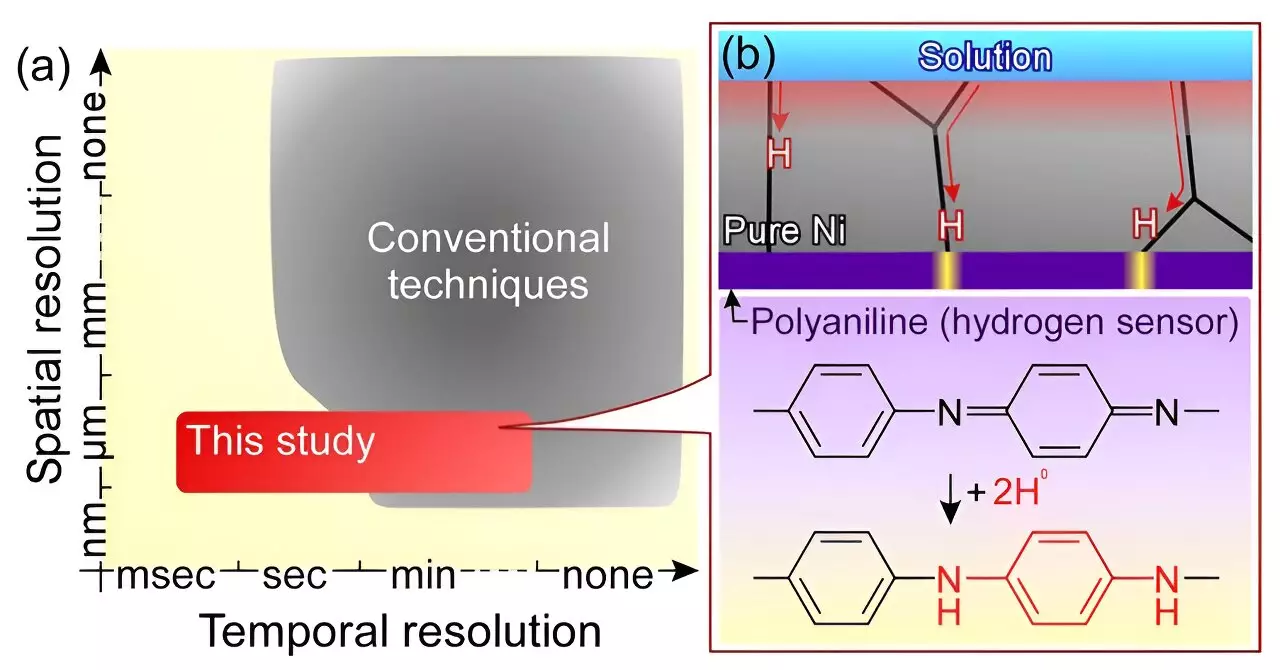

Hydrogen, being carbon dioxide free, is often considered as a potential source of clean energy. However, transitioning to a hydrogen-based society requires overcoming several technical challenges. To develop advanced materials for hydrogen-related applications, researchers need a deep understanding of hydrogen behavior in alloys. Current technology falls short in this area. Detecting atomic state hydrogen, the smallest atom in the universe, is challenging due to its unique characteristics. In order to address this issue, a group of researchers has developed a new and simple visualization technique using an optical microscope and polyaniline layer.
The research team, led by Hiroshi Kakinuma from Tohoku University, has successfully filmed the flow of hydrogen atoms in pure nickel using their new visualization technique. By harnessing an optical microscope and a polyaniline layer, they were able to analyze the flow of hydrogen atoms based on the color distribution of the polyaniline layer. The color of the polyaniline layer changes when reacting with hydrogen atoms, allowing for real-time observation of hydrogen behavior with unprecedented high spatial and time resolutions. This breakthrough opens up possibilities for better understanding hydrogen behaviors in alloys and facilitating the development of highly functional materials.
Through their visualization technique, the researchers discovered that hydrogen atoms in pure nickel preferentially diffused through grain boundaries in disordered Ni atoms. The color change of the polyaniline layer from purple to white indicated the presence of hydrogen atoms in the metal. This finding highlights the significance of the geometrical structure of grain boundaries in influencing hydrogen diffusion. Grain boundaries with large geometric spaces showed greater hydrogen flux. These experimental results provide valuable insights into the relationship between the atomic-scale structure of pure nickel and the diffusion behavior of hydrogen.
The new visualization technique is not limited to pure nickel but can be applied to other metals and alloys, such as steels and aluminum alloys. The ability to observe and analyze hydrogen behaviors in different materials will greatly facilitate the understanding of microscopic hydrogen-material interactions. This knowledge can then be utilized in alloy design, leading to the development of highly functional materials for various hydrogen-related applications. Additionally, the visualization technique can be further combined with simulations to deepen our understanding of the complex interactions between hydrogen and different materials.
The breakthrough in visualizing the atomic state of hydrogen using an optical microscope and polyaniline layer is a significant step forward in understanding hydrogen behaviors in alloys. This technique provides high spatial and time resolutions, allowing for real-time observation and analysis of the flow of hydrogen atoms. The knowledge gained from this research has the potential to accelerate the development of efficient alloy design and contribute to the establishment of a hydrogen energy-based society. With further advancements and applications, this visualization technique has the potential to revolutionize our understanding of hydrogen behavior in various materials and drive the development of clean energy technologies.
Natural gas leaks are a growing concern in both urban and rural settings, with potential…
Recent groundbreaking research at the University of Vienna has unveiled a novel interplay of forces…
In recent years, perovskites have garnered significant attention in the fields of materials science and…
For decades, astronomers have probed the depths of the Milky Way, grappling with two perplexing…
Foreign direct investment (FDI) in developing nations has long been heralded as a path to…
As spring beckons in April and May, stargazers have the unique opportunity to witness nature's…
This website uses cookies.